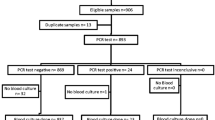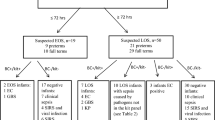Abstract
Group B streptococcus (GBS) is a leading cause of invasive disease in infants. Accurate and rapid diagnosis is crucial to reduce morbidity and mortality. Real-time polymerase chain reaction (PCR) targeting the dltR gene was utilised for the direct detection of GBS DNA in blood and cerebrospinal fluid (CSF) from infants at an Irish maternity hospital. A retrospective review of laboratory and patient records during the period 2011–2013 was performed in order to evaluate PCR and culture for the diagnosis of invasive GBS disease. A total of 3570 blood and 189 CSF samples from 3510 infants had corresponding culture and PCR results. Culture and PCR exhibited concordance in 3526 GBS-negative samples and 13 (25 %) GBS-positive samples (n = 53). Six (11 %) and 34 (64 %) GBS-positive samples were positive only in culture or PCR, respectively. Culture and PCR identified more GBS-positive infants (n = 47) than PCR (n = 43) or culture (n = 16) alone. Using culture as the reference standard, the sensitivity, specificity, and positive and negative predictive values for PCR on blood samples were 71.4 %, 99.2 %, 25 % and 99.9 %, and for CSF samples, they were 60 %, 97.8 %, 42.9 % and 98.9 %, respectively. The sensitivity and positive predictive values were improved (blood: 84.6 % and 55 %; CSF: 77.8 % and 100 %, respectively) when maternal risk factors and other laboratory test results were considered. The findings in this study recommend the use of direct GBS real-time PCR for the diagnosis of GBS infection in infants with a clinical suspicion of invasive disease and as a complement to culture, but should be interpreted in the light of other laboratory and clinical findings.
Similar content being viewed by others
References
Le Doare K, Heath PT (2013) An overview of global GBS epidemiology. Vaccine 31:D7–D12. doi:10.1016/j.vaccine.2013.01.009
Verani JR, McGee L, Schrag SJ; Division of Bacterial Diseases, National Center for Immunization and Respiratory Diseases, Centers for Disease Control and Prevention (CDC) (2010) Prevention of perinatal group B streptococcal disease—revised guidelines from CDC, 2010. MMWR Recomm Rep 59:1–36
Royal College of Obstetricians and Gynaecologists (RCOG) (2012) The prevention of early-onset neonatal group B streptococcal disease. Green-top guideline no. 36, July 2012
Di Renzo GC, Melin P, Berardi A, Blennow M, Carbonell-Estrany X, Donzelli GP, Hakansson S, Hod M, Hughes R, Kurtzer M, Poyart C, Shinwell E, Stray-Pedersen B, Wielgos M, El Helali N (2015) Intrapartum GBS screening and antibiotic prophylaxis: a European consensus conference. J Matern Fetal Neonatal Med 28:1–17. doi: 10.3109/14767058.2014.934804
Edmond KM, Kortsalioudaki C, Scott S, Schrag SJ, Zaidi AK, Cousens S, Heath PT (2012) Group B streptococcal disease in infants aged younger than 3 months: systematic review and meta-analysis. Lancet 379:547–556. doi:10.1016/S0140-6736(11)61651-6
Health Protection Surveillance Centre (HPSC) (2014) Report on invasive group B streptococcal infections in Ireland, quarters 1–4 2014. Available online at: http://www.hpsc.ie/A-Z/Other/GroupBStreptococcalDisease/EpidemiologicalData/BiannualReports/File,14217,en.pdf. Accessed 15 June 2015
Kim SC, Kim S, Lee DH, Choi SR, Kim JS (2015) Effect of blood volume in standard anaerobic blood culture bottles of the BacT/ALERT 3D system used for the detection of pathogens and time to detection. PLoS One 10:e0116728. doi:10.1371/journal.pone.0116728
Connell TG, Rele M, Cowley D, Buttery JP, Curtis N (2007) How reliable is a negative blood culture result? Volume of blood submitted for culture in routine practice in a children’s hospital. Pediatrics 119:891–896
Venkatesh M, Flores A, Luna RA, Versalovic J (2010) Molecular microbiological methods in the diagnosis of neonatal sepsis. Expert Rev Anti Infect Ther 8:1037–1048. doi:10.1586/eri.10.89
Lebovitz EE, Burbelo PD (2013) Commercial multiplex technologies for the microbiological diagnosis of sepsis. Mol Diagn Ther 17:221–231. doi:10.1007/s40291-013-0037-4
Loonen AJ, Wolffs PF, Bruggeman CA, van den Brule AJ (2014) Developments for improved diagnosis of bacterial bloodstream infections. Eur J Clin Microbiol Infect Dis 33:1687–1702. doi:10.1007/s10096-014-2153-4
Espy MJ, Uhl JR, Sloan LM, Buckwalter SP, Jones MF, Vetter EA, Yao JD, Wengenack NL, Rosenblatt JE, Cockerill FR 3rd, Smith TF (2006) Real-time PCR in clinical microbiology: applications for routine laboratory testing. Clin Microbiol Rev 19:165–256
Pammi M, Flores A, Leeflang M, Versalovic J (2011) Molecular assays in the diagnosis of neonatal sepsis: a systematic review and meta-analysis. Pediatrics 128:e973–e985. doi:10.1542/peds.2011-1208
Lamy MC, Dramsi S, Billoët A, Réglier-Poupet H, Tazi A, Raymond J, Guérin F, Couvé E, Kunst F, Glaser P, Trieu-Cuot P, Poyart C (2006) Rapid detection of the “highly virulent” group B Streptococcus ST-17 clone. Microbes Infect 8:1714–1722
Tann CJ, Nkurunziza P, Nakakeeto M, Oweka J, Kurinczuk JJ, Were J, Nyombi N, Hughes P, Willey BA, Elliott AM, Robertson NJ, Klein N, Harris KA (2014) Prevalence of bloodstream pathogens is higher in neonatal encephalopathy cases vs. controls using a novel panel of real-time PCR assays. PLoS One 9:e97259. doi:10.1371/journal.pone.0097259
Jordan JA, Durso MB (2005) Real-time polymerase chain reaction for detecting bacterial DNA directly from blood of neonates being evaluated for sepsis. J Mol Diagn 7:575–581
de Zoysa A, Edwards K, Gharbia S, Underwood A, Charlett A, Efstratiou A (2012) Non-culture detection of Streptococcus agalactiae (Lancefield group B Streptococcus) in clinical samples by real-time PCR. J Med Microbiol 61:1086–1090
van den Brand M, Peters RP, Catsburg A, Rubenjan A, Broeke FJ, van den Dungen FA, van Weissenbruch MM, van Furth AM, Kõressaar T, Remm M, Savelkoul PH, Bos MP (2014) Development of a multiplex real-time PCR assay for the rapid diagnosis of neonatal late onset sepsis. J Microbiol Methods 106:8–15. doi:10.1016/j.mimet.2014.07.034
Golden SM, Stamilio DM, Faux BM, dela Cruz WP, Shoemaker CT, Blackmon CL, Stassen SD, Clark VM, Smith JW, Johnson OL (2004) Evaluation of a real-time fluorescent PCR assay for rapid detection of Group B Streptococci in neonatal blood. Diagn Microbiol Infect Dis 50:7–13
Chiba N, Murayama SY, Morozumi M, Nakayama E, Okada T, Iwata S, Sunakawa K, Ubukata K (2009) Rapid detection of eight causative pathogens for the diagnosis of bacterial meningitis by real-time PCR. J Infect Chemother 15:92–98. doi:10.1007/s10156-009-0670-3
Reier-Nilsen T, Farstad T, Nakstad B, Lauvrak V, Steinbakk M (2009) Comparison of broad range 16S rDNA PCR and conventional blood culture for diagnosis of sepsis in the newborn: a case control study. BMC Pediatr 9:5. doi:10.1186/1471-2431-9-5
Wellinghausen N, Wirths B, Franz AR, Karolyi L, Marre R, Reischl U (2004) Algorithm for the identification of bacterial pathogens in positive blood cultures by real-time LightCycler polymerase chain reaction (PCR) with sequence-specific probes. Diagn Microbiol Infect Dis 48:229–241
Favaro M, Savini V, Favalli C, Fontana C (2013) A multi-target real-time PCR assay for rapid identification of meningitis-associated microorganisms. Mol Biotechnol 53:74–79. doi:10.1007/s12033-012-9534-7
Corless CE, Guiver M, Borrow R, Edwards-Jones V, Kaczmarski EB, Fox AJ (2000) Contamination and sensitivity issues with a real-time universal 16S rRNA PCR. J Clin Microbiol 38:1747–1752
Melin P, Efstratiou A (2013) Group B streptococcal epidemiology and vaccine needs in developed countries. Vaccine 31:D31–D42. doi:10.1016/j.vaccine.2013.05.012
Mancini N, Carletti S, Ghidoli N, Cichero P, Burioni R, Clementi M (2010) The era of molecular and other non-culture-based methods in diagnosis of sepsis. Clin Microbiol Rev 23:235–251. doi:10.1128/CMR.00043-09
Melin P (2011) Neonatal group B streptococcal disease: from pathogenesis to preventive strategies. Clin Microbiol Infect 17:1294–1303. doi:10.1111/j.1469-0691.2011.03576.x
Caliendo AM, Gilbert DN, Ginocchio CC, Hanson KE, May L, Quinn TC, Tenover FC, Alland D, Blaschke AJ, Bonomo RA, Carroll KC, Ferraro MJ, Hirschhorn LR, Joseph WP, Karchmer T, MacIntyre AT, Reller LB, Jackson AF; Infectious Diseases Society of America (IDSA) (2013) Better tests, better care: improved diagnostics for infectious diseases. Clin Infect Dis 57:S139–S170. doi:10.1093/cid/cit578
National Institute for Health and Clinical Excellence (NICE) (2012) Antibiotics for early-onset neonatal infection: antibiotics for the prevention and treatment of early-onset neonatal infection. NICE clinical guideline 149, August 2012
Schroeder EA, Petrou S, Balfour G, Edamma O, Heath PT; Health Protection Agency Group B Streptococcus Working Group (2009) The economic costs of Group B Streptococcus (GBS) disease: prospective cohort study of infants with GBS disease in England. Eur J Health Econ 10:275–285
Bergseng H, Bevanger L, Rygg M, Bergh K (2007) Real-time PCR targeting the sip gene for detection of group B Streptococcus colonization in pregnant women at delivery. J Med Microbiol 56:223–228
Peters RP, de Boer RF, Schuurman T, Gierveld S, Kooistra-Smid M, van Agtmael MA, Vandenbroucke-Grauls CM, Persoons MC, Savelkoul PH (2009) Streptococcus pneumoniae DNA load in blood as a marker of infection in patients with community-acquired pneumonia. J Clin Microbiol 47:3308–3312. doi:10.1128/JCM.01071-09
Darton T, Guiver M, Naylor S, Jack DL, Kaczmarski EB, Borrow R, Read RC (2009) Severity of meningococcal disease associated with genomic bacterial load. Clin Infect Dis 48:587–594. doi:10.1086/596707
Acknowledgements
The authors would like to thank Dr. Kathryn Harris, Great Ormond Street Hospital for the discussion and for providing details of the sip assay in advance of its publication and Dr. Robert Mulhall, Temple Street Children’s University Hospital for the assistance with the R software. The authors would like to acknowledge the Staff of the Irish Meningococcal and Meningitis Reference Laboratory, Temple Street Children’s University Hospital and Department of Clinical Pathology, Rotunda Hospital, in particular Prof. Philip Mayne and Dr. Melanie Cotter, Department of Biochemistry/Endocrinology and Department of Haematology, Rotunda Hospital, respectively, for the provision of laboratory results.
Author information
Authors and Affiliations
Corresponding author
Ethics declarations
Conflict of interest
The authors declare that they have no conflict of interest.
Electronic supplementary material
Below is the link to the electronic supplementary material.
ESM 1
(DOCX 51.7 kb)
Rights and permissions
About this article
Cite this article
Meehan, M., Cafferkey, M., Corcoran, S. et al. Real-time polymerase chain reaction and culture in the diagnosis of invasive group B streptococcal disease in infants: a retrospective study. Eur J Clin Microbiol Infect Dis 34, 2413–2420 (2015). https://doi.org/10.1007/s10096-015-2496-5
Received:
Accepted:
Published:
Issue Date:
DOI: https://doi.org/10.1007/s10096-015-2496-5




